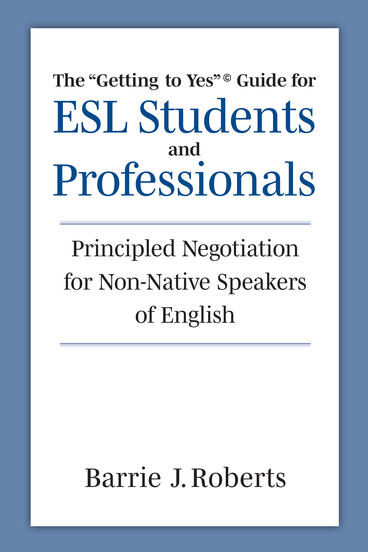The "Getting to Yes" Guide for ESL Students and Professionals
Principled Negotiation for Non-Native Speakers of English
Guiding non-native speakers of English through the international bestseller’s four-step negotiation method
Description
Getting to Yes, developed at the Harvard Negotiation Project, has been an international bestseller on win-win “principled” negotiations since 1981. Its four-step method has helped millions of people negotiate successfully with friends, relatives, business partners, customer service agents, opposing counsel, government officials, and other adversaries. Native speakers of English can easily and enjoyably learn the method by simply reading the book. But for non-native speakers of English, the vocabulary, idioms, phrasing, examples, and references can be difficult to understand. These readers may not be able to use Getting to Yes to negotiate in English on an equal footing with more fluent English speakers.
The Getting to Yes Guide for ESL Students and Professionals prepares non-native speakers of English to join the global community of people who use Getting to Yes to negotiate win-win agreements in English. It provides page-by-page explanations of over 1,000 words, phrases, concepts, and examples that these readers may misunderstand; short stories that use these new words and concepts to help readers apply them to new contexts; delightful cartoons to highlight main ideas; optional ESL activities; and a glossary of the key negotiation idioms and terms used in Getting to Yes. In this guide, author Barrie J. Roberts applies her experience as a public interest attorney, court Alternative Dispute Resolution administrator, ESL instructor, and court interpreter trainer to help readers improve their professional-level English along with their negotiation skills.
Benefits for teachers:
- Each Chapter Guide provides a ready-made lesson plan with activities to do before, while, and after reading each chapter of Getting to Yes
- The book can be used as a recommended self-study reference
- This book can be used for selected chapters of Getting to Yes or for a complete standalone course on Getting to Yes for non-native speakers of English or Generation 1.5 students
- Optional activities throughout the book can be assigned for in or out of the classroom. These include activities for reading comprehension, vocabulary building, paraphrasing, critical thinking, discussing, and writing
- Short stories written to accompany each chapter require students to apply new vocabulary and negotiation concepts to real-world disputes
Barrie J. Roberts has worked as a public interest attorney for Legal Services of Northern California, Inc., as the Alternative Dispute Resolution (ADR) Administrator for two southern California courts, and as an ESL/ ESP instructor at UC Berkeley. She created the term “Mediation as a Second Language” (MSL) to describe her approach to teaching mediation and negotiation to non-native speakers of English. She has over 20 years of experience teaching mediation and negotiation to international students at UC Berkeley, and has taught negotiation to international lawyers and LL.M. students at the Chapman University Fowler School of Law. With Maria Ceballos-Wallis, she is a co-founder of InterpretADR, which provides online and in-person ADR trainings for court interpreters.
Reviews
“This is a book filled with tips and tools to help non-native speakers understand more deeply and correctly the masterpieces of negotiation studies and apply them to real-life negotiations.”
- Tetsuo Morishita, Professor, Sophia University (Japan)
“This is a book for English-language learners that doesn’t feel like an ESL book. Roberts has adroitly factored in the needs of English language learners and made accessible to international students a book that a generation of lawyers (including myself) were trained on in negotiation classes in US law schools and elsewhere. Roberts seamlessly provides additional cultural and language information in connection with phrases and cultural references, so that readers always feel included in the topic rather than an outsider looking in. A fantastic resource for anyone interested in negotiation who is not a fluent English speaker, and a fantastic model for companion books for other subjects.”
- Stephen Horowitz, Professor of Legal English, Georgetown Law
News, Reviews, Interviews
Listen: Author Interview on The Study Legal English Podcast | April 8, 2024

